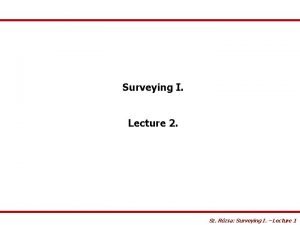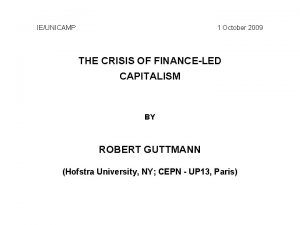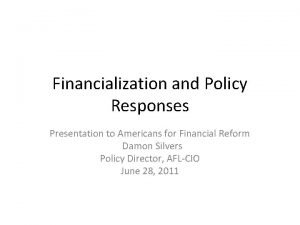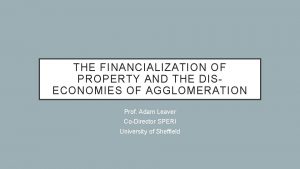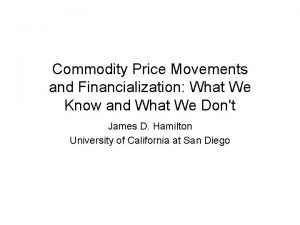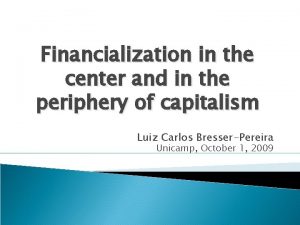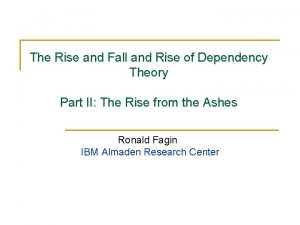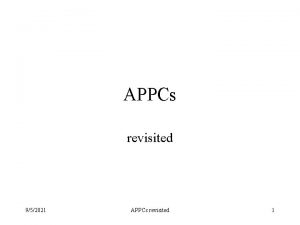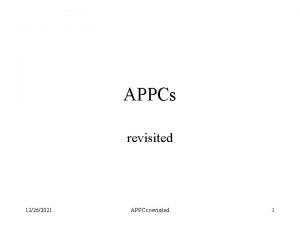Financialization revisited the rise and fall of financeled






























- Slides: 30

Financialization revisited: the rise and fall of finance-led capitalism � Robert Guttmann 2017

金融化的另類觀點 • Gerald Epstein (2005)提供金融化的定義(Definition) • financialization “means the increasing role of financial motives, financial markets, financial actors and financial institutions in the operation of the domestic and international economies. ” • Greta Krippner 運用統計資料說明美國的領導企業是由誰在掌控的, 並且將金融化的起因追朔到 1979年停滯性經濟危機以及雷根時代 的金融自由化。 • Eckhard Hein and Engelbert Stockhammer 認為金融化導致所得不均 與資源錯誤配置(從生產性投資轉移到短期的投機)

Definition of phenomenon -Gerald Epstein (2005) a disproportionate increase of the financial-services sector, the explosion in the size and variety of financial markets, the dominance of financial motives, and the heavy accumulation of financial assets and liabilities among a wide range of actors. • 補充 • • 是對自 1980 -2010之間的金融資本主義發展的描述 廠商的負債對業主權益(debt/equity)比率不斷上升 金融服務業的所得佔GDP的比率不斷上升 經由金融 具的中介(資產證券化),讓實質資產、勞務、風險更容易(與貨幣)進 行交易,使得民眾更容易理順他的資產與所得。

分析 • 比較靜態 • One may be concerned with the distributional impact benefiting holders of financial assets (see T. Palley, 2007), • the other with the profit-rate differences between financial and non-financial firms (see J. Bellamy Foster, 2007), • a third with the growing size of the finance sector, • I would like to provide here instead a more comprehensive, integrative, and dynamic approach to the financialization process.

financial centralization • How and why non-financial actors accumulate financial assets such as bonds or stocks. • This kind of asset is inherently attractive because of its liquidity as well as its mobility. It also serves as an alternative source of income (interest, dividends, capital gains) and gives its owner greater command in the marketplace, a modicum of power. • I would like to define this propensity in favor of financial assets by nonfinancial actors as a matter of financial centralization, • This proportional increase in financial assets and liabilities on the balance sheets of non-financial actors coincided with the rapid growth of the institutions and markets providing finance, a trend we shall characterize as one of financial concentration. • That expansion was fed by the simultaneous deregulation, computerization, and globalization of finance.

financial growth dynamic • Growth became more dependent on higher debt levels • and became subject to recurrent asset bubbles while a steadily rising financial income share created a lot of re-distributional pressure on (stagnant) profit shares and (broadly declining) wage shares • – a phenomenon witnessed in nearly all advanced capitalist nations during the quarter century preceding the crisis of 2007/8. • As the asset bubbles collapsed one after another, falling asset prices clashed with an inelastic debt structure. That clash imposed crisis-induced adjustments as desperate debtors had to slash spending, sell off assets into declining markets, and get debt levels down – all this to avoid turning illiquidity into insolvency. Even before the Great Recession of 2007/8, the world faced many incidences of financial instability.

financial centralization • Financial centralization denotes a process whereby non-financial actors, both firms as well as households, “financialize” inasmuch as they end up accumulating much larger stocks of financial assets and liabilities. • thereby derive a much larger share of their total income in the form of financial income (e. g. interest, dividends, capital gains), • but they also expose themselves to higher (fixed-cost) debt servicing charges in the face of rising debt levels. • These parallel changes in their income-payment structure naturally make these non-financial actors prone to accord financial motives much more space in their decision-making and prioritizing choices.

Money-market funds • The birth of financialization can be dated to 1975 in the United States with the introduction of money-market funds. • These funds invest in highly liquid money-market instruments (e. g. Treasury bills, commercial paper) • while offering their investors deposit-like shares that can be withdrawn on demand. • Unlike traditional savings deposits which at that point had maximum ceilings on their interest rates imposed by the Fed, the money-market funds offered market yields that were higher than the Fed’s ceilings.

Pension plans • 從確定給付制(defined-benefit plans)到確定提撥制(defined-contribution plans) • 確定提撥制(defined-contribution plans) • Those tax advantages obscured the fact that with defined-contribution plans future benefit pay-outs were no longer pre-determined in advance by a corporate promise (as used to be case with the defined-benefit plans), but depended instead on accumulated portfolio returns so that the risk was thereby transferred from the employer to the workers. • This change led an even larger (and younger) number of Americans becoming investors who were thus motivated to know about the inner workings of financial markets. • the majority of workers liked the fact that they had now gained direct personal control over their private pension plans when they were turned from defined-benefit plans into defined-contribution plans. • 開放勞退自提自選 雙贏-王儷玲 https: //money. udn. com/money/story/5629/3723091

Reagan’s tax reform • 雷根上台第一年即簽署通過〈1981年經濟復甦法案(Economic Recovery Tax Act of 1981),該法案將所得稅最高級距的稅率從 70%砍到 50%,最低稅率 從 14%砍到 11%,並將資本利得稅砍到最高 15%。 • in 1981 and in 1986, thereby slashing the top marginal tax rate from 70 percent to just 28 percent. Suddenly it made a lot of sense for top earners in particular to gain more income, • His radical 1981 tax reform came at a moment when successful disinflation would cause a gradual, but steady decline of interest rates to take root and go on over many years to boost the bond and stock markets. • The result was a huge boost to the income share going to the top 10 percent comprising the managerial class in the United States. • Perhaps even more importantly, stock options reinforced another crucial pillar of financial centralization, namely the dictate of shareholder value maximization, which became the guiding principle of corporate governance in the 1980 s.

Shareholder value maximization • US corporations had seen their share prices end up seriously undervalued in the wake of accelerating inflation causing systematic valuation errors • Once inflation had been wrung out of the system by mid-1982, the US stock market started one of the strongest bull markets ever. Driving this boom was a group of aggressive “corporate raiders” attacking a wide array of US companies, especially those considered particularly undervalued, with hostile takeover bids which they financed by issuing high-yielding “junk” bonds that had been popularized in the early 1980 s by investment bank Drexel. • When the corporations chose to defend themselves against these raids, they had to convince mutual funds and/or pension funds owning large chunks of their shares to side with them and not sell out to the raiders. they did so under the condition that the firm restructure in order to significantly raise share prices. • Firms spend more and more on financial manipulations (e. g. share buybacks, stock splits) and less on productive investments. Shareholder value maximization helped generate a widespread obsession with quarterly earnings. Longer-term objectives, such as skill formation or research and development, get neglected even though they may be crucial for the long-term profitability of the firm.

The firm as an asset bundle • 1971年布里敦森林體制崩潰(尼克森shock),因此 1974年決定廢除資本與匯率 管制,到了1980年此一廢除行動延伸到全世界,導致資本市場在全球整合, 自由的跨境流動。進而導致多國籍企業在全球活耀,創造全球供應鏈。 • 多國籍企業通常是控股公司,其轄下的子公司對母公司而言就是眾多資產的 一部份。 • The global market leaders today are in that sense better understood as holding companies managing bundles of productive and financial assets at their disposal, • who shuffle around their strategic holdings. As such they are not necessarily wedded any longer to a particular product even when that product is what put the firm originally on the map. • Shareholder value maximization, with its relentless emphasis on current earnings, makes firms less vested in patiently building a long-term market position in a specific industry and instead shifting the focus of attention to accumulation of cash, a high rate of self-financing, financial manipulations to increase share prices

Financial concentration • Both banks and non-bank financial institutions have ended up absorbing significantly larger shares of a nation’s gross domestic product, employment, or total corporate profit. Finance is thus today a much larger sector in the economy of the advanced capitalist nations. Why? • meso-economic level of analysis • through which we can see how finance as a system connects the micro-level of individual actors functioning as debtors and investors to the macro-level of a nation’s savings, business investment, consumption, government spending, and foreign trade balance.

3. 1 Funds replace bank deposits as primary source of savings • Eurocurrency markets, • A major financial innovation in the early 1960 s, As domestic interest-rate ceilings kept domestic deposit rates often below surging inflation rates during the 1970 s, US banks would encourage their corporate clients to deposit their funds in Eurodollars at market rates overnight. They would also borrow from their overseas subsidiaries, since Eurodollar loans were cheaper than domestic loans in the absence of regulatory costs. • negotiable certificates of deposits, excess bank reserves known as “federal funds, ” bankers’ acceptances, commercial paper, and so on. All these new instruments got a huge boost from the introduction of money-market mutual funds in 1975 which soon became the most active buyers of such money-market instruments.

3. 1 Funds replace bank deposits as primary source of savings • When money-market funds took root in the late 1970 s, they squeezed commercial banks greatly. • The Fed’s flow-of-funds data (now called “financial accounts”) show a steady decline of insured bank deposits from 52 percent of total short-term funding of the US finance sector in 1984 to just 31 percent in 2007 whereas the share of money-market fund assets rose from 5 percent to 21 percent. • The national-income data of the US Commerce Department’s Bureau of Economic Analysis (BEA) pertaining to the category of “traditional bank-based credit intermediation” shows that the commercial-banking activity of taking deposits and making loans actually declined from about 3. 1 percent of GDP in 1985 to 2. 4 percent in 2007.

3. 2 Securities replace loans as the primary channel of credit • Compared to the inherently volatile interest income associated with loans, the issue and/or trading of securities provides banks greater and more stable income sources in the form of fees, commissions, and trading profits. • Sellers (“issuers”) also have reason to prefer securities over loans. • These allow them to tap a much broader supply of funds. • Securities also come with lower costs than loans, in addition to being advantageous in terms of disclosure of information, requiring more formalized information in terms of income and balance-sheet statements whereas nosy bankers rely on relational information • securities offer lenders (i. e. “buyers”) liquidity and give them an exit option while loans are commitments hard to get out of.

explosion of new financial markets since the 1980 s • such as high-yield corporate bonds previously known as “junk bonds” or emerging-market bonds, derivatives, as well as loan-securitization products. • The transaction volume of financial markets has also surged, with the Fed’s financial accounts showing the value of traded equities and fixed-income securities in the United States to have grown from 107 percent of GDP in 1980 to 323 percent of GDP in 2007. This increase was also helped by steadily rising stock-market prices.

official measure of growth by the finance sector • “value added” of GDP, the finance sector itself managed to expand from 4. 9 percent of American GDP in 1980 to 8. 3 percent in 2006. • in terms of total output (or revenues), in which case the same national income data from America’s Bureau of Economic Analysis shows this very sector to have grown from 9. 5 percent of GDP in 1980 to 15. 6 percent in 2007. • This broader market-finance measure includes both traditional and alternative (i. e. hedge funds, private-equity funds, venture capital) asset management, pension-fund administration, derivatives trading and origination, equities and fixed-income trading, as well as broker-dealer services (including underwriting fees).

Securitization • pass-through securities whose income flows generated by the underlying loan pool (e. g. interest, repayment of principal) get passed onto their holders after deduction of origination and servicing fees going to the issuer. • US government itself which encouraged securitization in the 1980 s when government-sponsored lenders Fannie Mae and Freddie Mac promoted mortgage-backed securities. • Securitization gained much more impetus when banks decided to move much of their lending activity off their balance sheets in the face of new capital requirements for bank loans under the Basel Accord of 1988.

Securitization • During the 2000 s, securitization moved beyond mortgages into the money markets, when banks and their special-purpose entities used to run their off-balance-sheet operation began to bundle other types of household debt (e. g. student loans, car loans, and credit cards) against which they issued asset-backed commercial paper (ABCP) to borrow funds for the launch of their long-term capital-market securitization instruments. • Securitization helped drive up household debt, as the fraction of consumer debt held in securitized form rose from 8 percent in 1980 to about 50 percent in 2006. • This increase in the household credit securitization share coincided with a rise in American household debt from 48 percent of GDP in 1980 to 103 percent in 2007.

Securitization • Most of that securitization-driven increase in household debt involved mortgage debt, as this innovation made it easier and cheaper to finance home purchases. It thereby amplified existing incentive biases in favor of US home ownership (e. g. tax deductibility of mortgage interest) and so contributed to the over-building of America. This problem became acute during the housing bubble of the 2000 s when two-thirds of all US homeowners turned their homes into cash registers by borrowing increasing amounts at an accelerating pace against their homes (through re-financings, second mortgages, home-equity loans) as home prices rose.

3. 3 The rise of shadow banking as network finance • Securitization is part of the so-called “shadow banking system, ” which also comprises the aforementioned money-market funds and certainly also the special-purpose entities which seek short-term funds in money markets (e. g. ABCP) in order to invest in longer-term instruments (e. g. mortgage-backed securities). • shadow bank without access to the Fed’s lender-of-last-resort facilities nor deposit insurance. • repurchasing agreements also known as “repos, ” a type of secured lending which rose from 5. 9 percent of US domestic non-financial sector debt in 1980 to 15. 5 percent in 2007. • banks often conduct reverse repos with hedge funds to fund the latter’s purchases of asset-backed securities and then turn around to use thereby acquired securities to engage in their own repo financing where they typically borrow funds from money market funds.

shadow banking • Shadow banking is not part of so-called “market finance, ” but instead better characterized as network finance. Its structure consists primarily of a web of intertwined insider networks also known as “over-the-counter markets” which connect banks, broker-dealers, money market funds, hedge funds, and special purpose entities through securitization instruments, money-market claims, and repos. • Financial Stability Board (2014) estimates shadow-banking to have grown to between $25 and $35 trillion in the United States. In terms of their output measure, shadow banks comprise somewhere between a quarter and thirty percent of the total finance sector. So, if we were to include them, shadow banks would easily push the output of the US finance sector from the official BEA figure of 15. 6 percent to over 20 percent of GDP.

3. 4 Increased financial profit extraction • The BEA’s national income data shows the proportion of total US corporate profits taken up by financial institutions to have risen spectacularly from 21. 2 percent in 1979 to a 46 percent peak in 2002 before settling into a 38 -41 percent range in the five-year period before the 2007 crisis amidst record high profits overall. Amidst that systemic crisis, the financial sector’s profits collapsed to minus 10 percent of the total in the first quarter of 2009, before bouncing back strongly to a 30 percent share by the end of 2010.

銀行寡占 • In 1990, the five largest US banks only controlled 9. 7 percent of total assets in that sector. At the end of 2013 their combined market share had risen to an astounding 44 percent. In less than a quarter century US banking has gone from a highly decentralized, still predominantly regional industry to a supra-national and highly concentrated structure whose leaders have amassed one to two trillion dollars in assets each. This has left us with a serious “too-big-to-fail” problem we need to tackle.

4. 1 The “debt economy” -Financial growth dynamic • One crucial aspect of financialization is that we have come to depend much more on debt financing of spending. • Corporate debt rose in the United States from 31 percent of GDP in 1980 to 50 percent in 2007. • Most of that growth was the result of securitization, above all mortgages, while the expansion of corporate debt also came about through bonds rather than loans. • This so-called debt economy has included the federal government as well. The US government’s (net) debt level rose from 26. 5 percent of GDP in 1980 to 68. 7 percent in 2011.

4. 2 The “bubble economy” • Minsky’s identification of financial factors underlying long waves stressed not just the rise of debt relative to income over several cycles, but also the ongoing increase in the prices of key assets, notably stocks and real estate, to ultimately unsustainable levels. • Financial assets, summed across all sectors, have grown much more rapidly than national output from a FA/GDP ratio in the US of 4. 8 in 1980 to a peak of 10. 7 in 2007 before falling back to about 10 in 2010. During the same period, the ratio of financial assets to tangible assets rose from its long-term postwar trend level of 1. 5 in 1980 to 3. 5 in 2010.

5 The systemic crisis of finance-led capitalism • “bubble economy” has been most pronounced in the United States. Americans have cultural biases which set them up for such speculative excesses more than other cultures, notably a get-rich-quick mentality and a positive attitude toward debt. • the dollar-based international monetary system and the privileged position occupied by the United States in that system. Having to supply other countries with dollars for their cross-border payments, the United States needs to run chronic balance-of-payments deficits with which to sustain steady outflows of dollars to the rest of the world. Those external US deficits are automatically financed by anyone outside the United States using dollars as an international medium of exchange or store of value. Thus, being the only country on the planet not having to face any external constraint, the United States can as a result run much more stimulative economic policies than anyone else without having to worry about its external position, the level of its foreign-exchange reserves, or exchange rates - a huge advantage which I have termed elsewhere “global seigniorage”

過度金融、過度消費成就他國的經濟成長 • The influx of funds generated by these securitization techniques financed a historic real-estate boom which fueled excess consumption in the US and export-led growth elsewhere. As Americans consumed the equivalent of 107 dollars for every 100 dollars they produced as income, their bubbledriven and debt-financed excess consumption absorbed the rest of the world’s expansion via foreign trade. This absorption not only helped sustain the rapid growth of China and other emerging-market economies (many of whom, like Brazil, benefited in addition from a supra-cyclical boom in commodities triggered by China’s breakneck expansion at doubledigit growth rates), but also enabled the European Union and the East Asian tigers as well as Japan to recover from their respective crises of the 1990 s. The entire world community (minus America) came to depend on export-led growth amidst declining wage shares at home!

new type of monetary protectionism • the post-crisis stagnation dynamic has also been fed by a new type of monetary protectionism. When the Fed launched its quantitative-easing program in 2009, it thereby drove down the USdollar against the euro. That exchange-rate effect of excessive easing helped amplify the subprime crisis’ asymmetric shock to the euro-zone and plunged its members into a systemic crisis (between October 2009 and May 2012). Once the European Central Bank adopted its own quantitative-easing program during 2012 it thereby drove down the euro which put added pressure on Japan and China. The latter’s slowdown collapsed the commodities’ super-cycle to hurt commodity producers like Russia or Brazil. Finally, the world’s financial institutions and markets have been severely hurt by the systemic crisis of 2007/08. • Key banks still carry large losses on their books and also find themselves squeezed by the spread of negative interest rates across the globe – an absolutely path-breaking new development whose implications we have yet to fully appreciate. • Add to this the rather substantial re-regulation effort pertaining to banks, in particular America’s Dodd-Frank Act of 2010 (most provisions of which have also been adopted in the United Kingdom and the European Union) and the global Basel III accord of 2010. The new regulatory restrictions are designed to slow down banks and force them to downsize considerably, hence they are no longer fueling credit-financed expansion or asset bubbles.
 Tricky dick: the rise and fall and rise of richard m. nixon
Tricky dick: the rise and fall and rise of richard m. nixon Math lesson
Math lesson Random sampling over joins revisited
Random sampling over joins revisited Rise and rise until lambs become lions
Rise and rise until lambs become lions Rise and rise again until lambs become lions
Rise and rise again until lambs become lions A union b example
A union b example The periodic daily rise and fall of ocean water
The periodic daily rise and fall of ocean water Fall of songhai empire
Fall of songhai empire Napoleon's rise and fall assignment
Napoleon's rise and fall assignment Rise and fall method surveying
Rise and fall method surveying Fall of qing dynasty
Fall of qing dynasty Rise and fall method surveying
Rise and fall method surveying Periodic rise and fall of sea level
Periodic rise and fall of sea level Timeline of napoleon
Timeline of napoleon The rise and fall of the voice in speaking.
The rise and fall of the voice in speaking. Ancient rome: the rise and fall of an empire cast
Ancient rome: the rise and fall of an empire cast Rome rise and fall of an empire
Rome rise and fall of an empire Relevance lost the rise and fall of management accounting
Relevance lost the rise and fall of management accounting The periodic daily rise and fall of ocean water
The periodic daily rise and fall of ocean water Hitler birth
Hitler birth Greek civilization began in an area dominated by
Greek civilization began in an area dominated by Mali rise and fall
Mali rise and fall The falling-rising tune is
The falling-rising tune is Function of intonation
Function of intonation Tesco carbon labelling
Tesco carbon labelling Hát kết hợp bộ gõ cơ thể
Hát kết hợp bộ gõ cơ thể Frameset trong html5
Frameset trong html5 Bổ thể
Bổ thể Tỉ lệ cơ thể trẻ em
Tỉ lệ cơ thể trẻ em Chó sói
Chó sói Tư thế worm breton là gì
Tư thế worm breton là gì









